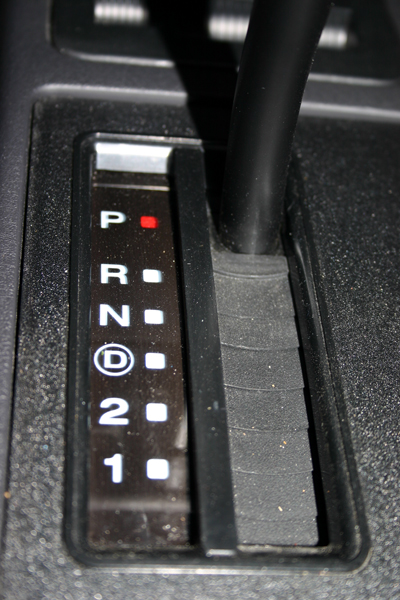- D5
- In Hondas and Acuras equipped with five-speed automatic transmissions
- this mode is used commonly for highway use (as stated in the manual), and uses all five forward gears.
- D4
- This mode is also found in Honda and Acura four- or five-speed automatics, and only uses the first four gear ratios.
- According to the manual, it is used for stop-and- go traffic, such as city driving.
- D3 or 3
- This mode is found in Honda, Acura, Volkswagen and Pontiac four-speed automatics and only uses the first three gear ratios.
- According to the manual, it is used for stop-and-go traffic, such as city driving.
- D2 and D1: These modes are found on older Ford transmissions (C6, etc).
- In D1, all three gears are used, whereas in D2 the car starts in second gear and upshifts to third.
- S or Sport
- This is commonly described as Sport mode.
- It operates in an identical manner as "D" mode, except that the upshifts change much higher up the engine's rev range.
- This has the effect on maximising all the available engine output, and therefore enhances the performance of the vehicle, particularly during acceleration.
- This mode will also downchange much higher up the rev range compared to "D" mode, maximising the effects of engine braking.
- This mode will have a detrimental effect on fuel economy.
- Hyundai has a Norm/Power switch next to the gearshift for this purpose on the Tiburon.
Some early GMs equipped with Torqueflite transmissions used (S) to indicate Second gear, being the same as the 2 position on a Chrysler, shifting between only first and second gears.
This would have been recommended for use on steep grades, or slippery roads like dirt, or ice, and limited to speeds under 40 mph. (L) was used in some early GMs to indicate (L)ow gear, being the same as the 2 position on aChrysler, locking the transmission into first gear.
This would have been recommended for use on steep grades, or slippery roads like dirt, or ice, and limited to speeds under 15 mph.
- + −, and M
- This is for the Manual mode selection of gears in certain automatics, such asPorsche's Tiptronic.
- The M feature can also be found in Chrysler and General Motors products such as the Dodge Magnum, Journey, and Pontiac G6, as well as Toyota's Camry, Corolla, Fortuner, Previa and Innova.
- Mitsubishi and some Audi models (Audi TT), meanwhile do not have the M, and instead have the + and -, which is separated from the rest of the shift modes; the same is true for some Peugeot products like Peugeot 206.
- Meanwhile, the driver can shift up and down at will by toggling the (console mounted) shift lever like a semi-automatic transmission.
- This mode may be engaged either through a selector/position or by actually changing the gears (e.g., tipping the gear-down paddles mounted near the driver's fingers on the steering wheel).
- Winter (W)
- In some Volvo, Mercedes-Benz, BMW and General Motors Europe models, a winter mode can be engaged so that second gear is selected instead of first when pulling away from stationary, to reduce the likelihood of loss of traction due to wheelspin on snow or ice.
- On GM cars, this was D2 in the 1950s, and is Second Gear Start after 1990.
- On Ford, Kia, and Honda automatics, this feature can be accessed by moving the gear selector to 2 to start, then taking your foot off the accelerator while selecting D once the car is moving.
- Brake (B)
- A mode selectable on some Toyota models. In non-hybrid cars, this mode lets the engine do compression braking, also known as engine braking, typically when encountering a steep downhill.
- Instead of engaging the brakes, the engine in a non-hybrid car switches to a lower gear and slows down the spinning tires.
- The engine holds the car back, instead of the brakes slowing it down.
- GM called this "HR" ("hill retarder") and "GR" ("grade retarder") in the 1950s. For hybrid cars, this mode converts the electric motor into a generator for the battery.
- It is not the same as downshifting in a non-hybrid car, but it has the same effect in slowing the car without using the brakes.
